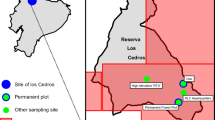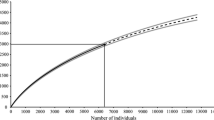Abstract
In order to document the species richness of plants and fungi in a tropical area, a trail of 500 m in tropical lowlands in the Chiriquí province, on the Pacific side of western Panama, was sampled each month during 2 years with 2 h dedicated to plants and 2 h dedicated to fungi, each by two botanists or mycologists respectively. The 24 sampling events yielded approximately 4,000 records of plants corresponding to 311 species as well as 1,614 records of fungi corresponding to approximately 567 species. Lists of more or less certain names of plants and fungi as well as voucher specimens are provided. The randomized species accumulation curve for plants approaches an asymptote and estimators yield stable values of 310–318 predicted plant species in the area of investigation. The curve for records of fungal species, however, did not saturate and all applied estimator functions failed to predict the total richness of fungi for the area convincingly. Two plant collections correspond to new records for Panama and 54 species and infraspecific taxa are new for the Chiriquí province. The identification of fungi is still in process and yielded two species probably new to science as well as 17 new records of species for Panama to date. In order to assess biodiversity patterns (e.g. fungi to plant ratios) of tropical fungi more accurately, it is necessary to repeat such investigations in other areas and to improve the tools for taxonomic identification of these highly diverse but mostly microscopic organisms.




Similar content being viewed by others
References
Arnold AE, Maynard Z, Gilbert GS et al (2000) Are tropical fungal endophytes hyperdivers? Ecol Lett 3:267–274
Bohannan BJM, Hughes J (2003) New approaches to analyzing microbial biodiversity data. Curr Opin Microbiol 6:282–287
Buée M, Reich M, Murat C et al (2009) 454 pyrosequencing analyses of forest soils reveal an unexpectedly high fungal diversity. New Phytol 184:449–456
Cannon PF (1999) Options and constraints in rapid diversity analysis of fungi in natural ecosystems. Fungal Divers 2:1–15
Cannon PF, Kirk PM, Cooper JA, Hawksworth DL (2001) Microscopic fungi. In: Hawksworth DL (ed) The changing wildlife of Great Britain and Ireland. Taylor & Francis, London, pp 114–125
Cantrell SA (2004) A comparison of two sampling strategies to assess discomycete diversity in wet tropical forests. Caribbean J Sci 40:8–16
Chao A (1987) Estimating the population size for capture-recapture data with unequal catchability. Biometrics 43:783–791
Chao A, Colwell RK, Lin C-W et al (2009) Sufficient sampling for asymptotic minimum species richness estimators. Ecology 90:1125–1133
Chaverri P, Vílchez B (2006) Hypocrealean (Hypocreales, Ascomycota) fungal diversity in different stages of tropical forest succession in Costa Rica. Biotropica 38:531–543
Coddington JA, Agnarsson I, Miller JA et al (2009) Undersampling bias: the null hypothesis for singleton species in tropical arthropod surveys. J Anim Ecol 78:573–584
Colwell RK, Coddington JA (1994) Estimating terrestrial biodiversity through extrapolation. Philos Trans R Soc Lond B 345:101–118
Correa MD, Galdames C, de Stapf MS (2004) Catálogo de las plantas vasculares de Panamá. Quebecor World, Bogota
Gange AC, Gange EG, Sparks TH, Boddy L (2007) Rapid and recent changes in fungal fruiting patterns. Science 316:71
Gotelli NJ, Colwell RK (2001) Quantifying biodiversity: procedures and pitfalls in the measurement and comparison of species richness. Ecol Lett 4:379–391
Guevara R, Dirzo R (1998) A rapid method for the assessment of the macromycota. The fungal community of an evergreen cloud forest as an example. Can J Bot 76:596–601
Guzmán G, Piepenbring M (2011) Los hongos de Panamá. Smithsonian Tropical Research Institute, Panama; Instituto de Ecología, Xalapa, Mexico; Universidad Autónoma de Chiriquí, David, Panama; Ideogramma, Mexico
Hammel BE (2003) Dioscoreaceae. In: Hammel BE, Grayum MH, Herrera C, Zamora N (eds) Manual de plantas de Costa Rica. Vol. II. Gimnospermas y monocotiledóneas (Agavaceae-Musaceae). Monog Syst Botan 92:552–565
Haug I, Wubet T, Weiss M et al (2010) Species-rich but distinct arbuscular mycorrhizal communities in reforestation plots on degraded pastures and in neighboring pristine tropical mountain rain forest. Trop Ecol 51:125–148
Hawksworth DL (1991) The fungal dimension of biodiversity: magnitude, significance, and conservation. Mycol Res 95:641–655
Hawksworth DL (1997) Inventorying a tropical fungal biota: intensive and extensive approaches. In: Janardhanan KK, Rajendran C, Natarajan K, Hawksworth DL (eds) Tropical mycology. Science Publishers, India, pp 29–50
Hawksworth DL (1998) The consequences of plant extinctions for their dependent biotas an overlooked aspect of conservation science. In: Peng C-I, Lowry PP (eds) Rare, threatened, and endangered floras of Asia and the Pacific rim, vol Academia Sinica Monograph Series 16. Institute of Botany, Taipei, pp 1–15
Hawksworth DL (2001) The magnitude of fungal diversity: the 1.5 million species estimate revisited. Mycol Res 105:1422–1432
Hawksworth DL (2004) Fungal diversity and its implications for genetic resource collections. Stud Mycol 50:9–18
Hawksworth DL, Mueller GM (2005) Fungal communities: their diversity and distribution. In: Dighton J, White JF, Oudemans P (eds) The fungal community: its organization and role in the ecosystem, 3rd edn. Taylor & Francis, New York, pp 27–37
Hibbett DS, Ohman A, Glotzer D et al (2011) Progress in molecular and morphological taxon discovery in fungi and options for formal classification of environmental sequences. Fungal Biol Rev 25:38–47
Hyde KD, Bussaban B, Paulus B et al (2007) Diversity of saprobic microfungi. Biodivers Conserv 16:7–35
Jumpponen A, Jones KL (2009) Massively parallel 454 sequencing indicates hyperdiverse fungal communities in temperate Quercus macrocarpa phyllosphere. New Phytol 184:438–448
Karasch P (2005) Beiträge zur Kenntnis der Pilzflora des Fünfseenlandes V. Ökologische Pilzkartierung auf einer Huteweide im Landkreis Weilheim (Oberbayern). Z Mykol 71:85–112
Kirk PM, Cannon PF, David JC, Stalpers JA (2001) Ainsworth and Bisbys dictionary of the fungi. CABI Bioscience. CAB International, Wallingford
Lensing JR, Wise DH (2006) Impact of changes in rainfall amounts predicted by climate-change models on decomposition in a deciduous forest. Appl Soil Ecol 35:523–534
Lilleskov EA, Fahey TJ, Horton TR et al (2002) Belowground ectomycorrhizal community change over a nitrogen deposition gradient in Alaska. Ecology 83:104–115
Lodge DJ, Cantrell S (1995a) Fungal communities in wet tropical forests: variation in time and space. Can J Bot 73(Suppl 1):S1391–S1398
Lodge DJ, Cantrell S (1995b) Diversity of litter agarics at Cuyabeno, Ecuador: calibrating sampling efforts in tropical rainforest. Mycologist 9:149–151
Mangelsdorff R, Piepenbring M, Perdomo O Diversity of Pucciniales, and their hosts on selected sites in western Panama. Biodivers Conserv (this issue)
Morales JF (2003) Poaceae. In: Hammel BE, Grayum MH, Herrera C, Zamora N (eds) Manual de plantas de Costa Rica. Vol. III. Monocotiledóneas (Orchidaceae-Zingiberaceae). Monog Syst Botan 93:598–821
Mueller GM, Schmit JP (2007) Fungal biodiversity: what do we know? What can we predict? Biodivers Conserv 16:1–5
Mueller GM, Bills GF, Foster MS (eds) (2004) Biodiversity of fungi, inventory and monitoring methods. Elsevier Academic Press, Amsterdam
O’Hara RB (2005) Species richness estimators: how many species can dance on the head of a pin? J Anim Ecol 74:375–386
Oksanen J, Blanchet FG, Kindt R et al (2010) Vegan: community ecology package. Ordination methods, diversity analysis, and other functions for community and vegetation ecologists. Available at http://cran.r-project.org/web/packages/vegan/index.html
Pedrós-Alió C (2006) Marine microbial diversity: can it be determined? Trends Microbiol 14:257–263
Pegler DN (1997) The larger fungi of Borneo. Natural History Publications, Kota Kinabalu
Pérez JM, Camino M (2000) Riqueza micológica en un sitio natural del Jardín Botánico Nacional. Rev Jard Bot Nac Univ Habana 21:133–137
Piepenbring M (2006) Checklist of fungi in Panama. Puente Biológico (Revista Científica de la Universidad Autónoma de Chiriquí) 1:1–190 + 5 plates
Piepenbring M (2011) Fungi of Panama. Available by STRI. http://biogeodb.stri.si.edu/fungi/. Cited 25 Aug 2011
Piepenbring M, Hofmann TA, Kirschner R et al (2011) Diversity patterns of Neotropical plant parasitic microfungi. Ecotropica 17:27–40
Pirozynski KA (1972) Microfungi of Tanzania. I. Miscellaneous fungi on oil palm. II. New Hyphomycetes. Mycol Pap 129:1–64 + 1 plate
R Development Core Team (2010) R: a language and environment for statistical computing. Available at http://cran.r-project.org
Rossman AY (1997) Biodiversity of tropical microfungi: an overview. In: Hyde KD (ed) Biodiversity of tropical microfungi. Hong Kong University Press, Hong Kong, pp 1–10
Rossman AY, Tulloss RE, O’Dell TE et al (1998) Protocols for an all taxa biodiversity inventory of fungi in a Costa Rican conservation area. Parkway, Boone
Schmit JP, Lodge DF (2005) Classical methods and modern analysis for studying fungal diversity. In: Dighton J, White JF, Oudemans P (eds) The fungal community: its organization and role in the ecosystem, 3rd edn. Taylor & Francis, New York, pp 193–214
Schmit JP, Mueller GM (2007) An estimate of the lower limit of global fungal diversity. Biodivers Conserv 16:99–111
Unterseher M, Schnittler M, Dormann C et al (2008) Application of species richness estimators for the assessment of fungal diversity. FEMS Microbiol Lett 282:205–213
Unterseher M, Jumpponen A, Öpik M et al (2011a) Species abundance distributions and richness estimations in fungal metagenomics–lessons learned from community ecology. Mol Ecol 20:275–285
Unterseher M, Westphal B, Amelang N et al (2011b) 3,000 species and no end—species richness and community pattern of woodland macrofungi in Mecklenburg-Western Pomerania, Germany. Mycol Progress (in press). doi:10.1007/s11557-011-0769-7
Van Herk CM, Aptroot A, Van Dobben HF (2002) Long-term monitoring in the Netherlands suggests that lichens respond to global warming. Lichenologist 34:141–154
Watling R (1995) Assessment of fungal diversity: macromycetes, the problems. Can J Bot 73(Suppl 1):S15–S24
Watling R (2010) The hidden kingdom. In: Boddy L, Coleman M (eds) From another kingdom, the amazing world of fungi. Royal Botanic Garden Edinburgh, Edinburgh
Woodson RE, Schery RW and collaborators (1943–1980) Flora of Panama. Ann Missouri Bot Gard 30–67
Acknowledgments
The authors thank numerous students and colleagues who collaborated in the field, namely J. M. Andrade, K. Araúz, G. Bethancourt, E. Caballero, L. Cáceres, O. Cáceres, V. Carrión, S. Castillo, D. Cruz, M. Cuevas, J. Espinosa, A. Gockele, A. K. Gómez, J. González, L. González, B. Henríquez, R. Kirschner, M. Mastrolinardo, L. Mayorga, E. Miranda, N. Moran, J. de Quiel, J. Ramos, I. de Rincón, S. Rudolph, L. Saldaña, K. Samaniego, I. Samudio, G. Steinbeisser, and J. Weisenborn. For identification of plants we are grateful to R. Mangelsdorff, R. Rincón, M. Stapf, and further members of the staff of the herbarium PMA, for the identification of fungi we were supported by K. Araúz, J. Fournier, R. Kirschner, R. Lücking, O. Perdomo, H. Sipmann, T. Trampe, N. Völxen, and E. Yilmaz. We thank R. Mangelsdoff for interesting discussions and help to improve the manuscript. S. Cronje improved the English of the manuscript. The institutional support of the Universidad Autónoma de Chiriquí (UNACHI), the National Authority of the Environment (ANAM, Panama), and the German Academic Exchange Service (DAAD) is acknowledged.
Author information
Authors and Affiliations
Corresponding author
Electronic supplementary material
Below is the link to the electronic supplementary material.
Rights and permissions
About this article
Cite this article
Piepenbring, M., Hofmann, T.A., Unterseher, M. et al. Species richness of plants and fungi in western Panama: towards a fungal inventory in the tropics. Biodivers Conserv 21, 2181–2193 (2012). https://doi.org/10.1007/s10531-011-0213-y
Received:
Accepted:
Published:
Issue Date:
DOI: https://doi.org/10.1007/s10531-011-0213-y




